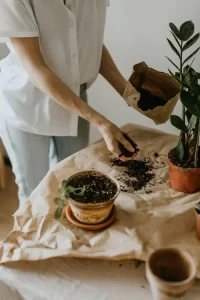By Jose German
With winter’s arrival, the pleasures of outdoor gardening are left behind. Trees and perennial flowers have gone dormant, and the weather outside is less than inviting. At the same time, the holiday season can bring unwelcome guests like stress and depression. While outdoor gardening is no longer an option, you can create a lush green environment inside your home with indoor plants. Indoor plants offer many health benefits, among them improved mental resilience in stressful times. Indoor winter greenery can lift your spirits and decrease anxiety levels.
Steps to create indoor greenery:
- Select plants that will meet your aesthetic preferences but at the same time have the resilience to survive for years to come.
- Before buying, research indoor plants and check their profiles to learn about maintenance and diseases. Especially important, do not mix plants with different soil and watering needs. Here are some hardy indoor plants you might consider:
Minimum watering: Cactuses, mini jade plant, aloe vera, snake plant, palm ponytail, dracaena marginata cane, and money tree.
Regular watering: Dum cane, glacier English ivy, monstera deliciosa, peace lily, spider plant, and asparagus fern.
- Choose the right pot. Double potting is the best approach for indoor plants. Select a decorative pot without drainage as the outside pot and inside it put your plant in a regular nursery plastic container with drainage in the bottom. Excess water will sink to the bottom of the decorative pot, helping the soil stay moist longer.
- Water only when needed. To determine when to water, insert your finger up to 2-3 inches into the soil and only water if the soil feels dry. Use room-temperature water to water your plants. Chilly water could shock them. Remember, too much water leads to sick plants.
- Winter’s stressful conditions can weaken your plants, inviting infestations of aphids, spider mites, and other pests. If one of your plants gets infected with a fungus or insect pest, isolate it and spray it with a Neem oil solution. Reapply the solution until the condition disappears.
Let there be light:
Most of our favorite indoor plants are of tropical origin, so winter’s shorter days can be a challenge for them. While some grow in shade in their natural habitats and do not require bright sunlight, limited sunlight can slow down the metabolism of your houseplants, causing some to go dormant. Providing as much light as possible will give your plants a boost. Here are some tips:
- If your plants have thrived over the years in the same spot, leave well enough alone – do not move them.
- Places with partial sunlight can be filled with plants that thrive in indirect light
- If plants are in spots that are sunny in other seasons but not in winter, move them near a south-facing window if possible; that is where they will get the most of that precious winter sunlight.
- Keep the plant’s leaves clean, making sure there is no dust. This will allow the plants to absorb more light.
- To compensate for any lack of light in your home, you can use grow lights or just add an indoor UV light bulb.
To fertilize or not to fertilize?
Soil quality is a key to a successful indoor garden. You can start with a soil mix including compost or some organic fertilizer. A combination of organic soil with compost is a wonderful way to improve the growth of your plants. The soil of your potted plants is often completely depleted after the first season; to control this, use a quality organic fertilizer in spring and summer.
Managing winter temperature
Indoor winter temperatures can become a problem. Like us, houseplants are living organisms and susceptible to changes of temperature. If you are comfortable with your indoor temperature, your plants probably will be too, but like you they are sensitive to drafts, excessive cold, and overheating. To protect them:
- Keep them away from frosty windows. Frost can severely damage your plants, and the area next to a window is likely cooler than the interior of the room.
- Keep them out of cold drafts.
- While we usually think of cold as the main challenge in winter, indoor overheating can also be problematic. Avoid placing them too close to heaters, radiators, or fireplaces, as the excessive dry heat can dehydrate the plants and burn the leaves.
Repotting?
 Although repotting is essential for indoor plants’ health, do not do it during the winter short of an emergency. Plants can easily recover from repotting stress during the growing season, but winter is more of a challenge.
Although repotting is essential for indoor plants’ health, do not do it during the winter short of an emergency. Plants can easily recover from repotting stress during the growing season, but winter is more of a challenge.
Indoor plants are more than a decoration. They bring great benefits to you and your family, boosting your winter mood and improving air quality by filtering toxins and converting carbon dioxide to oxygen. Keep them healthy, and you will continue to enjoy your plants for years to come.
